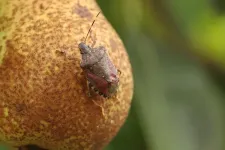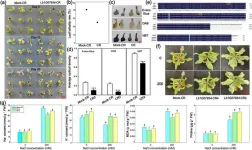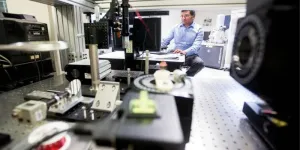(Press-News.org) A new study uncovers the intricate molecular mechanisms that regulate leaf senescence in apple plants, focusing on the crucial role of the E3 ligase enzyme, MdPUB23, and its interaction with the ABI5 protein. This research provides valuable insights into how plants manage stress responses and maintain growth, offering potential applications in improving crop yield and stress resistance.
Leaf senescence is a vital phase in the life cycle of plants, impacting overall plant health and yield. Abscisic acid (ABA) is a plant hormone that accelerates leaf senescence in response to environmental stress. However, the precise regulatory mechanisms of ABA-triggered leaf senescence are not fully understood. Due to these challenges, there is a need for in-depth research to explore the molecular pathways involved.
Researchers from Shandong Agricultural University and Yantai Academy of Agricultural Sciences conducted a study (DOI: 10.1093/hr/uhae029) published on January 30, 2024, in Horticulture Research, investigating the role of MdPUB23, an E3 ubiquitin ligase, in ABA-induced leaf senescence in apple plants. The findings revealed that MdPUB23 interacts with the ABI5 protein, promoting its degradation and thereby delaying the senescence process.
The study examined the interaction between MdPUB23 and ABI5, a key regulatory protein in the ABA signaling pathway. Through experiments including yeast two-hybrid assays, pull-down assays, and bimolecular fluorescence complementation, researchers demonstrated that MdPUB23 physically interacts with ABI5. Further analysis showed that MdPUB23 facilitates the ubiquitin-dependent degradation of ABI5, crucial for delaying ABA-triggered leaf senescence. Additionally, they observed that the expression of MdPUB23 decreases during leaf senescence and under ABA treatment, suggesting a feedback regulation mechanism. These insights into the MdPUB23-ABI5 interaction provide a new understanding of the molecular control of leaf senescence.
Dr. Jian-Ping An, a leading researcher in plant molecular biology, stated, "This discovery highlights the intricate regulatory mechanisms plants employ to balance growth and stress responses. By understanding how MdPUB23 modulates ABI5 stability, we can develop strategies to improve crop resilience and productivity."
The findings from this study have significant implications for agricultural practices. By manipulating the expression of MdPUB23, it may be possible to extend the lifespan of leaves, enhancing photosynthetic efficiency and crop yield. Additionally, this research opens new avenues for developing stress-resistant plant varieties, contributing to sustainable agriculture and food security in the face of changing climate conditions.
###
References
DOI
10.1093/hr/uhae029
Original Source URL
https://doi.org/10.1093/hr/uhae029
Funding information
This work was financially supported by grants from the Natural Science Foundation of China (32372642), the Development Plan of the Youth Innovation Team of the Higher Education Institutions in Shandong Province (2022KJ326), and Wuhan Botanical Garden Scientific Research Support Project (E3559901).
About Horticulture Research
Horticulture Research is an open access journal of Nanjing Agricultural University and ranked number one in the Horticulture category of the Journal Citation Reports ™ from Clarivate, 2022. The journal is committed to publishing original research articles, reviews, perspectives, comments, correspondence articles and letters to the editor related to all major horticultural plants and disciplines, including biotechnology, breeding, cellular and molecular biology, evolution, genetics, inter-species interactions, physiology, and the origination and domestication of crops.
END
Fountain of youth for plants: E3 ligase's role in leaf longevity
2024-06-05
ELSE PRESS RELEASES FROM THIS DATE:
Drones and AI harnessed to monitor invasive stink bugs
2024-06-05
Researchers in Italy have unveiled the first successful application of commercial drones combined with artificial intelligence (AI) to monitor the invasive agricultural pest, Halyomorpha halys, commonly known as the brown marmorated stink bug. This research, published in the SCI journal Pest Management Science, marks a significant advancement in the use of unmanned aerial vehicles (UAVs) for automated monitoring of invasive species.
Halyomorpha halys is notorious for its extensive damage to orchard crops across North America and southern Europe. In Italy, this invasive pest caused an ...
Unlocking salt resistance: sea lavender's genetic secret revealed
2024-06-05
Recent research has uncovered the genetic mechanisms behind sea lavender's (Limonium bicolor) salt tolerance by studying basic helix–loop–helix (bHLH) transcription factors. Identifying 187 bHLH genes, the study highlights their roles in salt gland development and stress responses. CRISPR-Cas9 validation demonstrated specific bHLH genes' critical role in enhancing salt tolerance, paving the way for future applications in crop improvement and saline soil management.
Basic helix–loop–helix (bHLH) transcription factors are essential for various plant processes, including ...
Six UTA faculty receive prestigious CAREER grants
2024-06-05
Six faculty members from The University of Texas at Arlington received more than $3.23 million in awards as part of the National Science Foundation’s (NSF) Faculty Early Career Development Program. Called CAREER, these awards are considered the NSF’s most prestigious for early-career faculty and are given to those who have the potential to serve as academic role models in research and education.
Between 2017 and 2022, UTA received nine CAREER awards; in 2023, it received six. Vice President of research and innovation Kate C. Miller called this “a true testament to the world-class research teams we’re assembling here in Arlington.”
“CAREER ...
Brain overgrowth dictates autism severity, new research suggests
2024-06-05
Some children with autism experience profound, lifelong difficulties like developmental delay, social struggles and even the inability to speak. Others experience more mild symptoms that improve with time.
The disparity in outcomes has been a mystery to scientists, until now. A new study, published in Molecular Autism by researchers at University of California San Diego, is the first to shed light on the matter. Among its findings: The biological basis for these two subtypes of autism develops in utero.
Researchers ...
MD Anderson Research Highlights for June 5, 2024
2024-06-05
HOUSTON ― The University of Texas MD Anderson Cancer Center’s Research Highlights showcases the latest breakthroughs in cancer care, research and prevention. These advances are made possible through seamless collaboration between MD Anderson’s world-leading clinicians and scientists, bringing discoveries from the lab to the clinic and back.
Recent developments at MD Anderson offer insights into a lower-intensity therapy combination for older patients with acute myeloid leukemia (AML), a novel T cell therapy for patients with bone marrow failure syndromes, a proof-of-concept study using MRI to detect metabolic changes inside tumors, a molecular target to overcome treatment resistance ...
New study finds many of the world’s most threatened species lack evidence of sufficient conservation efforts
2024-06-05
-With images-
A new study has revealed alarming gaps in the implementation of conservation interventions for thousands of the world's most threatened species.
The research, published in the journal Nature, shows that most terrestrial plant and animal species at risk of extinction from threats like habitat loss, over-exploitation for trade, and invasive species are not receiving the appropriate types of conservation efforts needed to protect them.
The study findings suggest that there is a serious mismatch between the ...
BU study: Black-specific incarceration rates are associated with Black firearm homicide rates
2024-06-05
(Boston)—Firearm-related injury remains a significant burden in the U.S. with more than 45,000 people dying from these injuries in 2020. Suicides continue to account for the majority of all gun deaths. The number of homicides due to gun violence decreased between 1990 and 2010, but the last decade has seen an uptick. Homicides now make up 45% of all gun-related deaths, and Black and other minorities are overrepresented among firearm homicide victims. Moreover, there has been a stark increase in incarcerated populations in the U.S since the 1980s largely due to differential drug sentencing, ...
New technique reveals how gene transcription is coordinated in cells
2024-06-05
The human genome contains about 23,000 genes, but only a fraction of those genes are turned on inside a cell at any given time. The complex network of regulatory elements that controls gene expression includes regions of the genome called enhancers, which are often located far from the genes that they regulate.
This distance can make it difficult to map the complex interactions between genes and enhancers. To overcome that, MIT researchers have invented a new technique that allows them to observe the timing of gene and enhancer activation in a cell. When a gene is turned on around the same time as a particular enhancer, it strongly suggests the enhancer ...
Major cause of inflammatory bowel disease discovered
2024-06-05
Researchers at the Francis Crick Institute, working with UCL and Imperial College London, have discovered a new biological pathway that is a principal driver of inflammatory bowel disease (IBD) and related conditions, and which can be targeted using existing drugs.
About 5% of the world’s population, and one in ten people in the UK1, are currently affected by an autoimmune disease, such as IBD, the umbrella term for Crohn’s disease and ulcerative colitis. These diseases are also becoming more common, with over half a million people living with IBD in the UK as of 2022, nearly double the 300,000 previously estimated2.
Despite increasing prevalence, current treatments do not ...
Cooperative proteins help the immune system identify and attack invaders
2024-06-05
LA JOLLA (June 5, 2024)—Bacteria, parasites, viruses—the immune system tackles them all. At the front line of the human immune response are cells called macrophages, which are responsible for correctly identifying intruders and then directing how the entire immune system responds. Researchers at the Salk Institute have now discovered a molecular mechanism that helps macrophages mount a coordinated response tailored to a specific immune challenge.
Activating macrophages requires the work of three versions of a protein complex called SWI/SNF: cBAF, ncBAF, and PBAF. Scientists already knew these variants had slightly different structures, but ...







